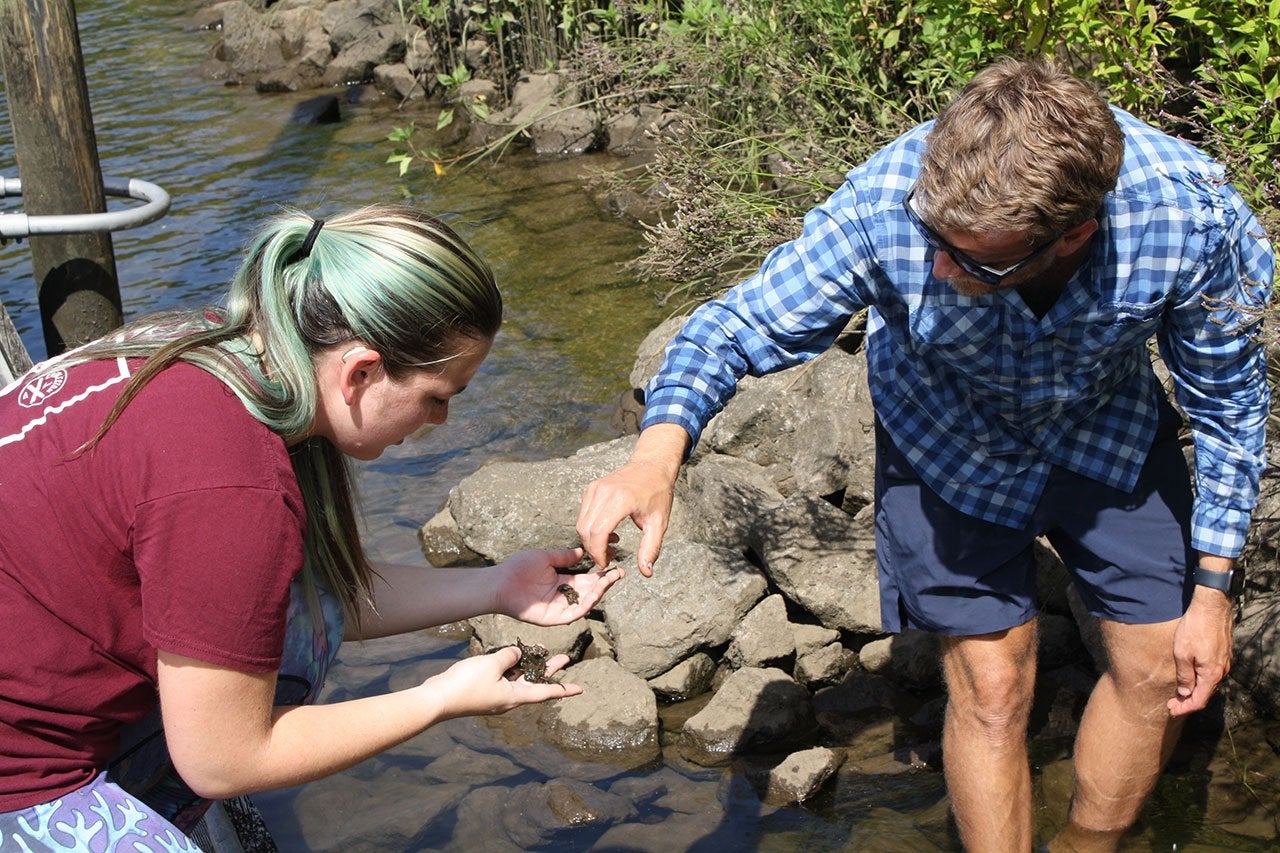Josie Shostak and Chris Freeman search for freshwater sponges in Moncks Corner, South Carolina.
Next time you go to a lake, pond or river, take a look at the thin sheets of organisms attached to the sides of docks and rocks. Among them you may find a cushiony creature like the ones Chris Freeman, visiting assistant professor of biology, has been finding all over the Lowcountry.
“A colleague of mine had been finding freshwater sponges in Tennessee, and I wanted a local project for students, so we started looking in local waterways and found our first sponge on a dock in North Charleston,” says Freeman, who studies coral reef ecology. “I also thought it would be a perfect way to study a new aspect of biodiversity in the region. Plus, since freshwater sponges in South Carolina are so understudied, we have an open book of opportunities.”
Freeman, together with rising junior Josie Shostak, who worked on two other research projects with him at Grice Marine Lab, submitted a proposal to study the diversity and distribution of freshwater sponges in South Carolina. They received a School of Sciences and Mathematics (SSM) Summer Research Award and, in 2021, began exploring South Carolina’s rivers, lakes and ponds – from Myrtle Beach to the Georgia state line to Greenville – in search of substrates like rocks, docks, pilings and vegetation, where sponges like to attach themselves.
“I enjoyed going to rural areas and raising awareness about the environment,” says Shostak, a marine biology major and environmental and sustainability studies and studio art double minor. “Many people didn’t even know about the existence of sponges, and they had been fishing at the site their entire lives.”
Once they had collected specimens, Freeman and Shostak started the process of identifying them. For each specimen, they cut off a chocolate chip–sized piece of tissue and dissolved it in bleach so that only the spicules (skeletal structures made of glass aka silica) remained. They could then identify the species from the unique characteristics (e.g., large vs. small; spiky vs. smooth) of the spicules and, when present, gemmules (think: ball-shaped baby sponges that are about the size of the end of a toothpick and have their own spicules).
“Josie and I have found approximately 10 of the about 30 species of freshwater sponges thought to be in North America,” says Freeman, noting that prior to their research, the last record of freshwater sponge research in South Carolina took place in the 1990s, when several species were discovered in Adams Pond, near Columbia. “We have new records for South Carolina, and it is very possible we have new species in our collection.”

A sample of a freshwater sponge Shostak and Freeman found as part of their research on freshwater sponges in South Carolina.
This summer, Shostak and Freeman have continued their work through another SSM Summer Research Award. The first thing Shostak noticed when she went out to collect more specimens is how the heat is impacting the sponge population; she found a dramatic reduction in the number of sponges from last summer and as temperatures increased over this summer.
“Sponges are so important to local ecosystems,” says Shostak, who presented her work at the Benthic Ecology Meeting in Portsmouth, New Hampshire, and the College’s Expo in the spring of 2022. “As filter feeders, they keep our water clean by consuming things like bacteria and other particles, act as homes for microbial symbionts and insects, and can potentially be a food source for larger aquatic animals.
“The local sponge population is definitely more diverse than what is in the records,” adds Shostak, who plans to pursue a master’s degree in environmental journalism after graduating from the College. “With greater biodiversity, it is likely that these ecosystems are healthier.”
Freeman and Shostak won’t know if their findings include new species until they have verified their IDs with the help of DNA barcoding, which they anticipate completing by spring 2023.
In the meantime, they are co-authoring a chapter on freshwater sponges in an aquatic organism field guide for the southeastern United States being organized by scientists at Clemson University.
Shostak also has plans to study in Homer, Alaska, this fall. She will be serving on the first response team for beached marine mammals and studying harbor porpoises with the National Oceanic and Atmospheric Administration (NOAA). Her field experience studying freshwater sponge diversity in South Carolina will certainly give her a distinct advantage.





